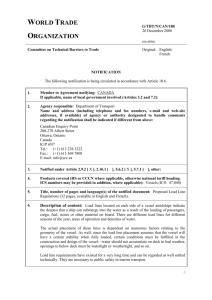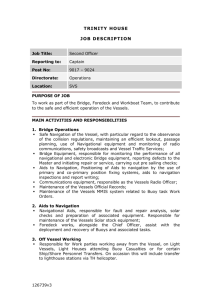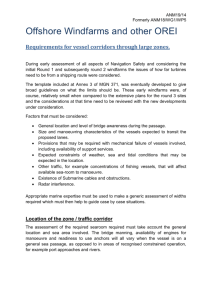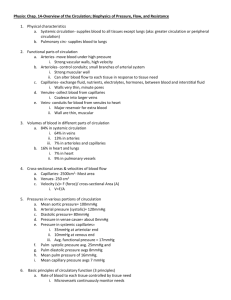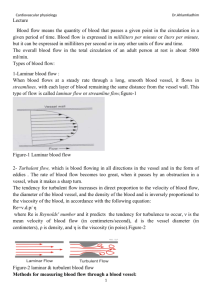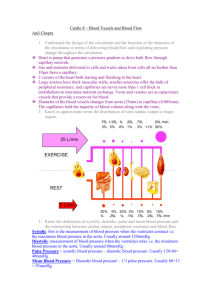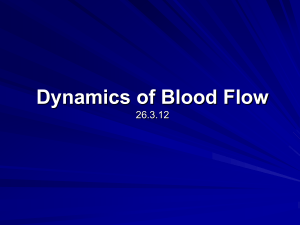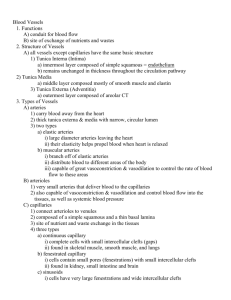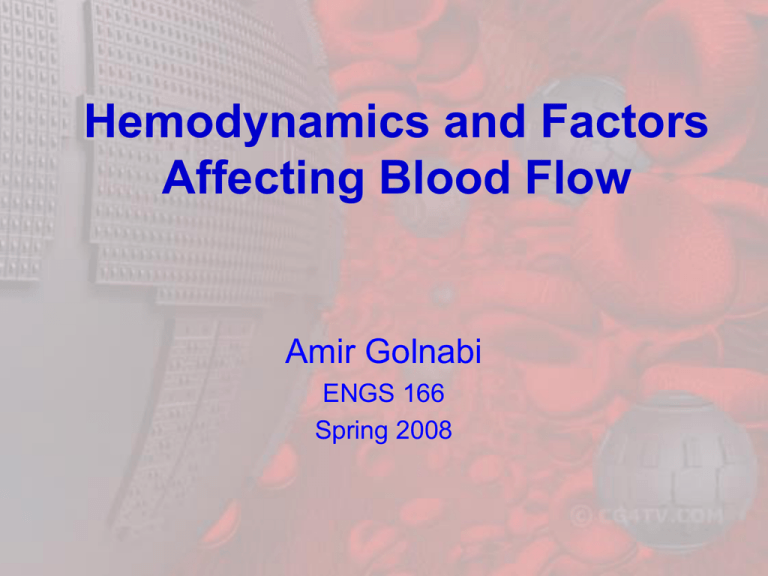
Hemodynamics and Factors
Affecting Blood Flow
Amir Golnabi
ENGS 166
Spring 2008
Outline:
• Blood Flow
• Blood Pressure
– Facts
– Mean Arterial Pressure
– Total Blood Volume
• Vascular Resistance
– Size Of The Lumen
– Blood Viscosity
– Total Length of Blood Vessel
• Conclusion
– Rate of Blood Flow
• References
Blood Flow:
• Blood flow: Amount of blood that flows through any tissue
in a given period of time (mL/min)
• Total blood flow: Volume of blood that circulates through
the systemic and pulmonary blood vessels each minute →
Cardiac Output (CO)
• Cardiac output (CO) = heart rate (HR) x stroke volume
(SV)
• Distribution of CO into different body tissues:
1. Pressure difference of different parts of the body
Pressure ↑ → Blood Flow ↑
2. Resistance of specific blood vessels to blood flow
Resistance ↑ → Blood Flow ↓
1. Blood Pressure (BP):
• Blood flow: ↑ Pressure → ↓ Pressure
• BP: Contraction of the ventricles → hydrostatic pressure
exerted by blood on the walls of a blood vessel.
• Normal BP in a young adult at rest:
– 110 mmHg during ventricular contraction, systole
– 70 mmHg during ventricular relaxation, diastole
– Systemic Circulation:
Tortora, Gerard, and Bryan Derrickson. Principles of Anatomy
and Physiology. Wiley, 2006. 747.
Blood Pressure (cont.):
• Mean Arterial Pressure (MAP): The average blood
pressure in arteries → closer to diastolic pressure during the
greater portion of the cardiac cycle
MAP = diastolic BP + 1/3(systolic BP – diastolic BP)
(80 + 1/3(120 – 80)) = 93 mmHg
• CO = HR x SV
• CO = MAP/R where R is the vascular resistance
• MAP = CO x R
• SV ↑ or HR ↑ → CO ↑
• and if R stays constant → MAP ↑
Blood Pressure (cont.):
• Total volume of blood in the cardiovascular
system:
• 5 liters of blood in total
– Modest decrease in BV → Homeostatic mechanism
– More than 10% → BP ↓
– Water retention → BP ↑
2. Vascular Resistance:
• Friction between blood and the walls of blood
vessels: resists to blood flow
• Vascular resistance depends on three factors:
(1) Size of the blood vessels
(2) Blood viscosity
(3) Total blood vessels length
2.1. Size of Blood Vessels:
• Size of the lumen of a blood vessel ↓ → Resistance to
blood flow ↑
• “forth power law”: the resistance increases in proportion to
the inverse of the forth power of the diameter:
1
R
d4
• Vasoconstriction: Narrowing of the vessels resulting from
contraction of the muscular wall of the vessels
• Vasodilation: Widening of the vessels resulting from
relaxation of the muscular wall of the vessels
• constant fluctuations → Resistance → BP
2.2. Blood Viscosity:
• Shearing force F
• Different layers of the blood move with different velocities
causing a shearing action (friction) between them
• Rate of shear (γ) is the relative displacement of one fluid
layer with respect to the next
– slope of the velocity profile: v/h
• Blood moves by the action of shear stress
– the force per area, τ = F/A
• Viscosity:
– η = shear stress / shear rate = τ / γ
2.2. Blood Viscosity (cont.):
• Blood:
– Plasma: 0.015 Poise
– Hematocrit (Ht): normally about 46% for men and 38% for women
plasma 1 2.5Ht
0.0151 2.5 0.46 0.032 Poise
• Factors:
– Size of blood vessels ↓ → Velocity (shear rate) ↑ → Viscosity ↓
– Temperature ↓ → Viscosity ↑
1ºC ↓ → Viscosity ↑ by 2%
2.3. total length of blood vessel:
• Resistance to blood flow through a vessel ≈ total length of
blood vessel
• Hypertension → additional blood vessels in the adipose
tissue → total blood vessel length is longer → resistance to
blood flow ↑ → blood pressure ↑
• For each extra kilogram of fat, an estimated 650 km (about
400 miles) of additional blood vessels can develop in our
body!!!
Rate of Blood Flow
P r 4
Poiseuille’s Law: F
8 l
– F: rate of blood flow
– ∆P: pressure difference between two ends of the vessel
– r: radius of the vessel
– η: blood viscosity
– l: length of the vessel
References:
• "An Introduction to Blood Pressure". Maryland Virtual High School of Science and
Mathematics. 04/27/2008 <http://mvhs.shodor.org/edgrid/bloodpressure/bptoblt.pdf>.
• Bipin , Upadhyay. "BLOOD VISCOSITY FUNCTIONAL PARAMETERS". COLLEGE OF
BIOMEDICAL ENGINEERING AND APPLIED SCIENCES. 04/28/2008
<http://www.biomedical.edu.np/biomed_files/>.
• Freeman, Scott. Biological Science. Upper Saddle River, NJ: Pearson Prentice Hall,
2005.
• Guyton, Arthur, and John Hall. Textbook of Medical Physiology. PA: Elsevier, 2006.
• Purves, William K.; David Sadava, Gordon H. Orians, H. Craig Heller (2004). Life: The
Science of Biology, 7th, Sunderland, Mass: Sinauer Associates, 954.
• Tortora, Gerard, and Bryan Derrickson. Principles of Anatomy and Physiology. Wiley,
2006.



